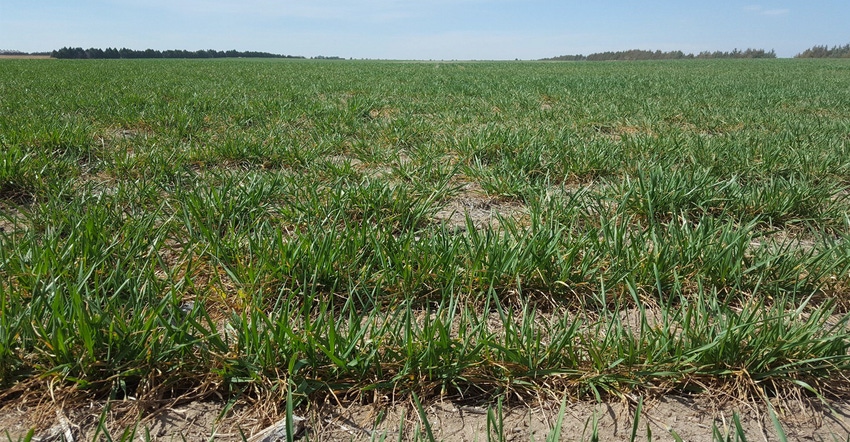January 26, 2018

Spring is the ideal time to apply nitrogen to winter wheat to ensure top yields. Adequate N levels promote tillering and a large head size, and is the primary factor determining the protein level of the grain at harvest. There are a few things to consider to optimize N applied to wheat.
First, scout fields for winterkill, pest pressure, or anything else that might reduce wheat stands and yield. As wheat begins to green up, it will be easy to determine if any underlying issues exist and if the wheat crop has high enough yield potential to warrant an N application.
There are online resources that can assist in determining potential wheat yield at different times of the year. Scouting is also an opportune time to take soil samples on each field if it has been more than a year or so since samples have been taken. By judging the yield potential of the wheat and knowing what residual N is available in the soil, you will be able to develop a plan for N.
In order to get the highest return on your N application, N should be topdressed no later than two weeks before jointing. This is during the period when wheat is actively tillering and growing. Head size is determined when wheat reaches Feekes 5, and any N that has been applied needs to have been moved into the root zone with moisture before that critical period. Because weather can be unpredictable, it is recommended to apply N between Feekes 3 and 4 to ensure the N reaches the root zone.
Topdressing is usually done using UAN solution or dry urea. Each can be equally effective if properly applied. The type of N used is usually determined by price and application equipment availability. When UAN is applied in no-till situations with heavy residue from the previous crop, some N may be tied up in the residue. Using streamer nozzles to concentrate the UAN in a few bands helps the N to penetrate through the residue. Similarly, dry urea can fall through much of the residue and avoid being tied up, which is one benefit of using a dry form of N.
If only a small amount of N is needed, applying N at the same time as your spring herbicide application can save time and money. Most herbicides can be tank-mixed with UAN without losing efficacy. Check herbicide labels for compatibility. When applied with herbicides, the N will be more uniformly spread over the wheat plants.
Although this type of coverage is ideal for herbicide and fungicide applications, it can cause severe leaf burn when applying high rates of UAN in this manner. Rates that deliver up to 20 pounds of N using this method will cause only minor leaf burn. UAN rates can be greater (not to exceed 40 pounds) if no surfactant is used or if applied during cool, non-humid weather.
Keep in mind that any decision on N applications should consider the price of wheat and N. Wheat removes approximately 1.2 pounds of N per bushel, and not all N applied will be removed at harvest. Some N will remain in the soil and residue, and will benefit the following crop.
It can be said that you get out what you put into something. Wheat is no different. Nitrogen management is only one piece of the puzzle. Adequate fertility provides the basis for potential grain yield and protein levels. Variety, precipitation and pest control determine most of the rest. Get your wheat off to the best start by giving it the N it needs to reach its potential.
Creech is a Nebraska Extension dryland cropping systems specialist.
About the Author(s)
You May Also Like




